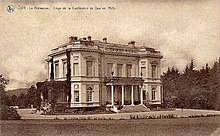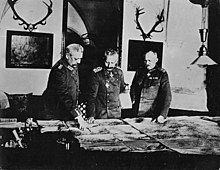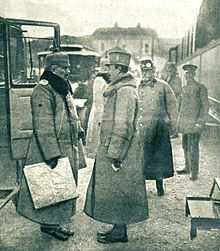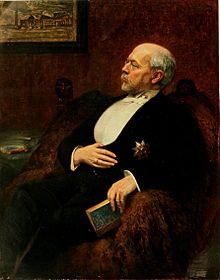Spa Conferences (First World War)

In 1918, several conferences bringing together the leaders of the Imperial Reich[Note 1] sometimes in the presence of Austro-Hungarian representatives, were convened in Spa in Belgium, the seat of the Oberste Heeresleitung (OHL), the supreme command of the Imperial German Army, since his installation in the city at the end of the winter 1918. Governmental, they were all chaired by the German Emperor Wilhelm II, with the assistance of the Reich Chancellor, and co-chaired by the Emperor-King Charles I when he is present. Also bringing together ministerial officials and high-ranking military personnel, both from the Reich and from the dual monarchy, these conferences were supposed, according to the German imperial government, to define the policy pursued by the Reich and its Quadruple[Note 2] allies, particularly in effecting a division of conquests, by the armies of the Central Powers, into territories to be annexed by the Reich and the dual monarchy, while defining within their respective conquests the zones of German and Austro-Hungarian influence.
The German general staff at Spa in 1918
[edit]At the request of the Dioscuri Paul von Hindenburg and Erich Ludendorff,[Note 3] German Emperor Wilhelm II issued an order transferring the Oberste Heeresleitung (OHL) to Spa at the beginning of 1918.[1]
A strategic choice
[edit]The choice of Spa for the location of the OHL constituted, for the military leaders of the Reich, a carefully considered decision. Indeed, at the beginning of 1917, Erich Ludendorff considered establishing the headquarters of the OHL in Spa, before choosing Bad Kreuznach, at the time better served by telephone and telegraph, allowing in command to wage war virtually in real time.[2]
While OHL strategists prepared the offensives planned for the beginning of 1918, the question of the move of the German high command was raised again. Indeed, the city has numerous hotels able to accommodate the staff services of the German army in the countryside.[1] It is also correctly connected to the railway network and benefits from greater proximity to the front, to which members of the general staff can therefore more easily reach.[1]
Installation in Spa
[edit]
The installation of the general staff services and its main officials begins from the month of february. On March 8, 1918, Hindenburg and Ludendorff arrive on site; the two military leaders live in town, each having settled in a requisitioned villa. However, the next day, the Dioscuri went to Avesnes-sur-Helpe, the command center of the army groups promised to be engaged in the offensives planned for spring.[1]
They are joined by Wilhelm II on 12 March; the emperor moved to the Villa Neubois, the Château de la Fraineuse being used as his official residence.[1]
Spa and its region quickly brought together the services of the general staff of all the armies of the Reich in the field. The operations section begins its preparations for its installation at the Grand Hôtel Bretagne on February 8. The other services are scattered throughout the region: the air force command is located in Verviers, while the town of Avesnes serves as a forward command post. Finally, the Valenciennes Museum of Fine Arts is regularly used for officer training.[3][1]
Participants
[edit]
During the four main conferences of 1918, German and Austro-Hungarian civil and military officials took part in the talks, each of the parties involved tried to assert their points of view during sometimes tense exchanges.
Presidency of emperors
[edit]The four conferences were chaired by Wilhelm II, the German Emperor. During the German-Austro-Hungarian meetings of 12 May 1918; 14 and 15 August 1918, the Hohenzollern shared the presidency with Charles I, Emperor of Austria and King of Hungary. This co-presidency allows Habsburg to maintain the appearance of an alliance between partners placed on an equal footing, by maintaining, in defiance of the reality of the balance of power, the fiction of an Austria-Hungary still able to weigh on the general policy of the Quadruple at this stage of the conflict.[4][Note 4]
Officially co-chaired by the two emperors, the conferences of May and August, allowed the Hohenzollern to demonstrate the predominance of the Reich in the alliance linking it to the dual monarchy. During the German-Austro-Hungarian conference of the 14th and 15th August, Wilhelm II presented himself to Charles I in an Austro-Hungarian uniform, while Charles wore a German uniform.[Note 5] During these meetings, the monarchs set the guidelines for relations between the two empires, establishing the general terms of the agreements in principle between the two monarchies, which their advisors must specify during subsequent negotiations.[5][6][3]
Civilians
[edit]
The Reich government is represented by the Reich Chancellor, Georg von Hertling, depending on the November 1, 1917 until September 30, 1918. He is assisted by the Secretary of State for Foreign Affairs: Richard von Kühlmann succeeds in this position, depending on the August 6, 1917 until July 8, 1918, then Paul von Hintze, between the July 9, 1918 and the October 3, 1918. Also occasionally present were Prussian ministers and close advisors to the Chancellor and the Secretary of State.[7][8]
Stephan Burián von Rajecz, Austro-Hungarian Minister of Foreign Affairs in office April 16At October 24, 1918, assists Emperor - King Charles I during the German-Austro-Hungarian meetings of May 12 and August 14, 1918.[9][10]
Military
[edit]The civil leaders of the two empires were not the only ones summoned to these conferences. Indeed, from the end of 1916, the Dioscuri, effectively exercising a "dictatorship" over the Reich, attended all government meetings organized by the chancellor at the request of the emperor. Thus, Paul von Hindenburg and Erich Ludendorff were present at all four meetings; the two German strategists are sometimes assisted by their main collaborators, Paul von Bartenwerffer, Erich von Oldershausen and Detlof von Winterfeldt.[11][8]
The Austro-Hungarian Chief of Staff Arthur Arz von Straußenburg accompanies his Emperor the August 14, 1918, during the only one of the four conferences attended by a high-ranking Austro-Hungarian soldier.[12]
Several conferences spread over five months
[edit]Several conferences are organized in Spa by the German government; historiography retains four main ones, summoned between May and September 1918: in May, July, August and September 1918. During two of them, only representatives of the Imperial and Prussian governments were invited; the other two were joined by Emperor-King Charles I, assisted by his Minister of Foreign Affairs, Stephan Burián von Rajecz.
Four conferences
[edit]
The four conferences between May 12 and the September 29, 1918 can be classified into two groups: the German imperial governmental conferences, bringing together the political and military leaders of the Reich, and the last two official meetings of Emperor Wilhelm and Emperor-King Charles I, theoretically on an equal footing equality.
Thus, the conferences of 2 and 3 of July and September 29, 1918, as well as the August 13, the first day of the conference in August, are similar to the councils of the German imperial crown, in which the Dioscuri, the main organizers of the Oberste Heeresleitung participate.
In addition to these German government conferences, there are the two German-Austro-Hungarian meetings of May 12 and 14-15 of August, 1918.
Relatively closely spaced in time from each other, they nevertheless took place in completely different political and military contexts: the May conference resulted in the dual monarchy being placed under supervision . The July meeting was held while the Reich still hoped to impose its peace conditions on the Allies: in fact, a final offensive was planned to be launched in Champagne on July 15, 1918. The August conference was held when the German and Austro-Hungarian armies had exhausted the means of their respective empires, in men and equipment, and showed themselves incapable of confronting the Allied breakthroughs, present or future. The September conference was held against the backdrop of the Bulgarian armistice and victorious Allied offensives on all fronts held by the Reich, the Dual Monarchy and the Ottoman Empire: while Allied troops exploited their victories in Macedonia, the Allied troops deployed on the Western Front pushed back exhausted German units towards the borders of the Reich.[13][14][8]
A careful preparation
[edit]Each of the conferences is the subject of careful preparation by the German officials, civil and military, who are convened there. These preparatory exchanges are of various nature, depending on whether the conference welcomes Austro-Hungarian officials or not.
When the German headquarters was to welcome Emperor Charles and his Foreign Minister, Reich officials met on numerous occasions beforehand. Thus, the German preparation for the conference of May 12, having to conclude with the vassalization of the double monarchy for the benefit of the Reich, causes the holding of multiple moments of negotiations between the members of the German and Prussian governments on the one hand, Hindenburg and Ludendorff on the other, in the days preceding Berlin, at the headquarters of the Reich Chancellery or at the headquarters of the German Foreign Ministry.[9]
When the conference only brings together German political, economic and military officials, the preparation only brings together the military and political leaders of the Reich: the Chancellor, the Secretary of State (or his deputy), the German Minister of War and the Dioscuri. Thus, the conference of the 2 and 3 of July, intended to definitively oust Secretary of State Richard von Kühlmann, was planned the day before during a meeting between the Reich Chancellor, the Minister of War and the Dioscuri, who then informed the Chancellor, Georg von Hertling, of their refusal to take into account the opinions of the Secretary of State who was then promised to be ousted.[15]
Main axes
[edit]Constant affirmation of German war aims
[edit]Each conference, unilateral or bilateral, constitutes the opportunity to formulate the German war aims in the hypothesis of a victory: the control of Belgium, of Poland, the vassalization of the double monarchy and the constitution of a vast European economic whole under the political and economic control of the Reich.[16]
The achievement of war aims constituted a cornerstone of German foreign policy until the final weeks of the conflict. Indeed, the four main conferences confirm the imperialist and expansionist policy of the Reich, and sometimes of its allies. Those in favor of seeking a compromise, not only with the Allies, but also with the members of the Quadruple, were in fact systematically dismissed by Paul von Hindenburg and his colleague Erich Ludendorff, who then exercised a military dictatorship in the Reich: May 12, Wilhelm II and the Dioscuri took Charles I through a veritable "path to Canossa"; July 3, 1918, the Dioscuri obtained the resignation of Richard von Kühlmann, who had just taken an official position in favor of a compromise peace with the Allies, and his replacement by Paul von Hintze, leader of the Pan-Germanists. Later, September 29, 1918, in a context marked by the Bulgarian defection and the rapid reconquest of Serbia by the Allies, the political and military leaders of the Reich, then militarily defeated and economically strangled by the Allied blockade, were convinced of the need to open negotiations with the Allies with a view to putting an end to hostilities. These same officials, however, continue to defend the maintenance of the provisions obtained during the peace negotiations signed by the members of the Quadruple with Russia, Ukraine and Romania.[17][18][9]
Furthermore, it appears to German officials that the war must allow the integration of the Reich and the dual monarchy into a vast political and economic whole constituted on the scale of the European continent. Thus, from the middle of 1916, German political leaders aspired to complete the process of political alignment of the dual monarchy with the Reich,[Note 6] thus completing the edifice aimed at strictly controlling the dual monarchy, reducing it to the rank of "another Bavaria".[Note 7] Despite the fierce opposition of the Emperor-King Charles, the process of placing the dual monarchy under strict supervision comes to an end: in fact, the conference in May, convened thanks to the revelation of The Sixtus[Note 8] affair sanctions the adoption of this political, military and economic supervision.[19][20][21][Note 9]
However, despite this consensus on the objectives pursued during the conflict, the exposition of these war aims also allows each member of the German government to defend positions that are sometimes divergent with those of other German imperial authorities: the satelliteization of certain territories appears satisfactory for some, mainly the military, while the representatives of the German Ministry of Foreign Affairs are in favor of the privileged use of commercial weapons as a means of controlling the territories thus anchored to the Reich.[16]
Faced with a worrying situation
[edit]
The conferences also provide the opportunity for members of the civilian government to explain to the military the deterioration of the internal situation, that of the Reich as well as that of the dual monarchy, just as it allows the military to expose certain aspects of exhaustion to civilians. military of the Reich.[22][23]
Thus, during the council of the German crown meeting on August 14, Chancellor Georg von Hertling presents at length the internal situation of the Reich, then engaged since the summer of 1914 in the world conflict. He insists in particular on the brigandage which rages in the countryside, the bands of plunderers seizing the harvests of helpless peasants; the food situation also generates high inflation while the Germans can no longer buy anything, due to shortages. In addition, the moral crisis experienced by the front quickly reached the country, notably through letters from soldiers to their families, informing them of the reality of the military situation and the absurdity of the orders given by the command. The dissemination of Allied propaganda in the Reich, facilitated by epistolary exchanges between the front and the rear, also contributed to demoralizing German units. Finally, during the month ofSeptember 1918, Erich Ludendorff, the main leader of the German general staff, was affected by the diplomatic failures suffered during the multiple attempts to open negotiations with the Allies: according to the neurologist who examined him at the request of his collaborators, but without his knowledge, during the month of September 1918, he suffers from severe depression.[24][25][26][22]
The dual monarchy was also experiencing a worrying internal situation at the beginning of 1918. In fact, the civilian populations were suffering a severe shortage, despite the rationing put in place since the loss of Galicia at the end of the summer of 1914. This rationing contributed to straining relations between Austria and Hungary, despite the renewal of the Ausgleich the previous year.[27][28]
Search for an honorable peace
[edit]Always accompanied by Emperor William, the negotiators mandated by the Reich, the main leader of the Quadruplice, set, sometimes in agreement with their counterparts from the dual monarchy placed under strict political and military control, the conditions for which they affirmed their readiness. to get out of the conflict.
From the Allied success of August 8, 1918, the conferences also aim to define a clear political line not only among Reich officials, but also with the leaders of the dual monarchy. Rejecting any idea of negotiation with the Allies until the month of August 1918, the German government then considered opening negotiations with a view to concluding a compromise peace; misinformed by Erich Ludendorff, the Reich government agreed August 13 on the concessions that he is ready to grant to his interlocutors from the opposing camp: the only evacuation of the Longwy- Briey[Note 10] steel basin is then simply envisaged by the German government, the other territories occupied by the Reich and its allies are then not not mentioned.[29]
The last two conferences, that of the 13th, 14th and 15th of August and that of September 29, are marked by the rebellion of members of the civil government against the Dioscuri Hindenburg and Ludendorff, the military ostensibly neglecting the seriousness of the internal situation in the Reich; Chancellor Georg von Hertling, supported by his ministers, multiplied initiatives towards the army command to impose an end to the conflict, without success. Alongside these internal exchanges, German leaders must take into account the increasingly insistent desire of their Austro-Hungarian counterparts to withdraw from the conflict as quickly as possible and at any cost.[22][25]
Only the continued deterioration of the military situation from August 8, 1918 pushes OHL military officials to request the opening of armistice negotiations. So, from the middle of august, German military leaders are experiencing moral despondency, but, by leading an orderly retreat allowing the installation of units on solid defensive positions, they still hope to succeed in forcing the Allies to open negotiations with a view to a peaceful peace in Western Europe, guaranteeing the positions conquered during the conflict, in the Balkans and in Russia. Finally, during the last conference, that of September 29, the hopes of Paul von Hintze and the members of the von Hertling cabinet were swept away by the confessions of Erich Ludendorff: he abruptly announced to them that the imperial army was no longer able to sustainably and effectively contain the multiple Allied offensives and to control the internal situation, characterized by the first Allied incursions into the Reich.[Note 11] The military obtained the resignation of Chancellor Hertling, hostile to any negotiation with the Allies and any internal reform before the end of the conflict, as well as the appointment of Max of Baden to the post of Reich Chancellor. He was charged with both the opening of negotiations with a view to the armistice and the implementation of political reforms, intended to transform the authoritarian Bismarckian Reich into a parliamentary monarchy.[30][31][32][24]
See also
[edit]Related articles
[edit]Conferences
[edit]- The conference of 12 May 1918
- The conference of 2 and 3 July 1918
- The conference of 13, 14 and 15 August 1918
- The conference of 29 September 1918
Other articles
[edit]- German Empire
- History of Austria-Hungary during World War I
- Stab-in-the-back myth
- Sixtus Affair
- Prince Maximilian of Baden
- Stephan Burián von Rajecz
- Georg von Hertling
- Paul von Hintze
- Richard von Kühlmann
- Charles I of Austria
- Wilhelm II
- Salzburg negotiations
- Fritz Fischer (historian)
Notes and references
[edit]Notes
[edit]- ^ Between 1871 and 1945 the official name of the German national state was Deutsches Reich, subsequently simply referred to as Reich .
- ^ The historian Pierre Renouvin defines the Quadruple as the central powers in the period between the October 5, 1915 and the September 29, 1918, chronological milestones of the Bulgarian intervention in the world war.
- ^ Inseparable from each other in the eyes of German public opinion, these two soldiers were likened to the Dioscuri of mythology by war propaganda.
- ^ By 1918, the dual monarchy was totally exhausted by the prolonged conflict. A year earlier, in April 1917, a report by Ottokar Czernin had already highlighted the Austro-Hungarian situation, which was considered worrying at the time.
- ^ This show of friendship masked major differences over the conduct of the war at that point in the conflict
- ^ From the 1900s onwards, the dual monarchy could no longer undertake anything successfully without the support of the Reich.
- ^ The Kingdom of Bavaria enjoyed a special status within the Reich, but this status nevertheless placed it in a subordinate position to the Kingdom of Prussia.
- ^ Ottokar Czernin, the Austro-Hungarian Foreign Minister, revealed the existence of secret talks with France, causing a huge scandal and renewed tension between the Reich and the dual monarchy.
- ^ The details of the customs union between the Reich and the Dual Monarchy were negotiated in Salzburg between 9 July and 15 October 1918, when the talks were finally suspended.
- ^ This industrial area, located in Meurthe-et-Moselle, has been occupied by the Reich since August 1914.
- ^ Allied long-range artillery fire and increasingly frequent air raids hit Reich territory.
References
[edit]- ^ a b c d e f Laparra & Hesse (2011, p. 69)
- ^ Laparra & Hesse (2011, p. 67)
- ^ a b Laparra & Hesse (2011, p. 70)
- ^ Fischer (1970, p. 361)
- ^ Le Naour (2016, p. 212)
- ^ Soutou (1989, p. 710)
- ^ Fischer (1970, p. 13)
- ^ a b c Fischer (1970, p. 621)
- ^ a b c Fischer (1970, p. 527)
- ^ Renouvin (1934, p. 602)
- ^ Renouvin (1934, p. 601)
- ^ Fischer (1970, p. 626)
- ^ Bled (2014, p. 399)
- ^ Renouvin (1934, p. 608)
- ^ Fischer (1970, p. 620)
- ^ a b Fischer (1970, p. 528)
- ^ Fischer (1970, p. 521)
- ^ Fischer (1970, p. 630)
- ^ Kennedy (1989, p. 298)
- ^ Bled (2014, p. 369)
- ^ Le Naour (2016, p. 207)
- ^ a b c Jardin (2008, p. 4)
- ^ Le Naour (2016, p. 287)
- ^ a b Jardin (2008, p. 6)
- ^ a b Le Naour (2016, p. 291)
- ^ Le Naour (2016, p. 328)
- ^ Le Naour (2016, p. 200)
- ^ Le Naour (2016, p. 201)
- ^ Le Naour (2016, p. 292)
- ^ Bled (2014, p. 400)
- ^ Le Naour (2016, p. 329)
- ^ Le Naour (2016, p. 332)
Bibliography
[edit]- Bled, Jean-Paul (2014). L'Agonie d'une monarchie: Autriche-Hongrie, 1914-1920. Paris: Tallandier. ISBN 979-10-210-0440-5.
- Fischer, Fritz (1970). Les Buts de guerre de l'Allemagne impériale (1914-1918) [Griff nach der Weltmacht]. Translated by Migeon, Geneviève; Thiès, Henri. Paris: Éditions de Trévise.
- Jardin, Pierre (2008-06-15). "La fin de la guerre en Allemagne". Revue historique des armées (in French) (251): 35–46. doi:10.3917/rha.251.0035. ISSN 0035-3299.
- Kennedy, Paul Michael (1989). Naissance et déclin des grandes puissances : transformations économiques et conflits militaires entre 1500 et 2000 [The Rise and Fall of the Great Powers]. Translated by Cochez, Marie-Aude; Lebrave, Jean-Louis (63 ed.). Paris: Payot, coll. Petite bibliothèque Payot.
- Laparra, Jean-Claude; Hesse, Pascal (2011). L'envers des parades: le commandement de l'armée allemande, réalités et destins croisés, 1914-1918. Paris: Éditions SOTECA. ISBN 978-2-916385-77-8.
- Le Naour, Jean-Yves (2016). 1918: l'étrange victoire. Paris: Perrin. ISBN 978-2-262-03038-4. OCLC 961212181.
- Renouvin, Pierre (1934). "La Crise européenne et la Première Guerre mondiale". Presses Universitaires de France, Coll. Peuples et Civilisations. 19: 500–502.
- Schiavon, Max (2011). L'Autriche-Hongrie dans la Première Guerre mondiale: la fin d'un empire. Collection "Les nations dans la Grande Guerre". Paris: Éditions SOTECA 14-18. ISBN 978-2-916385-59-4. OCLC 770601364.
- Soutou, Georges-Henri (1989). L' or et le sang: les buts de guerre économiques de la Première Guerre Mondiale. Nouvelles études historiques. Paris: Fayard. ISBN 978-2-213-02215-4.
